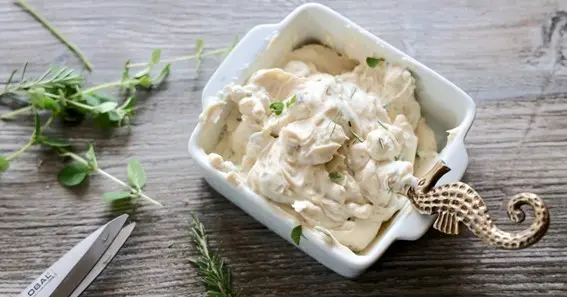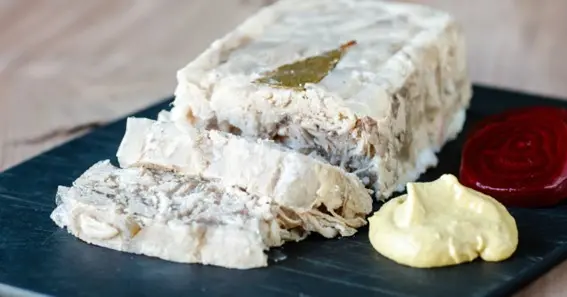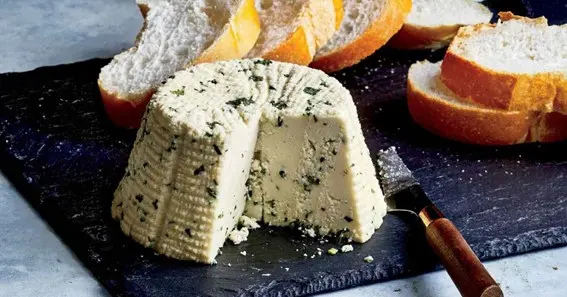What is Head Cheese? Head cheese, or brawn, is made from pig or cow heads. Despite its name, it doesn’t include cheese. The meat jelly or organ sausage generally tastes fine, chilled, or at room temperature. Herb—and spice-flavored gelatinous broth soaks the meat, making meals delicious and versatile.
What is Head Cheese?
Head cheese is a cold cut that does not contain cheese, despite its name. When cooked, pig or calf head meat softens and separates readily from bones. Natural collagen in bones and connective tissues turns soup into gelatin when it cools. Mix this with beef. Preparing the mixture for cooling and hardening involves adding several herbs, spices, and vegetables. You may cut it and serve it as an appetizer, sandwich, or charcuterie board when firm. Depending on the preparation, it can go from firm and meaty to gelatinous. Despite its lowly origins, many cuisines laud head cheese for its taste and versatility. Let us read about What is Head Cheese.
Exploring the Nutritional Benefits of Head Cheese

Head cheese, a European delicacy, derives from pig or calf heads. Eat this jelly-like, flavourful cold cut, warm or cold. It’s not cheese, despite its name. Head cheese is good alone or on charcuterie boards. It is popular during holidays. Maintaining quality and safety requires proper care.
Preparation Process
Head cheese is made by boiling pig or calf heads, trotters, and tongues. Long, slow cooking takes hours. It brings out flavors and gelatin, which firms the mixture is chilling. Remove and slice bone meat into little pieces. Drain and boil soup to gelatinize. Serve meat and water in molds to cool and firm, then season with herbs and spices. This makes the product tasty and tough to cut.
Ingredients and Variations
Head meat and gelatinous broth are key. Spice it up with garlic, vinegar, black pepper, bay leaves, and pickled veggies. Neighborhoods and households may have distinct plans. Some have veal, beef, or chicken for flavor and texture. Some recipes spice up classics using nuts, eggs, or vegetables.
Nutritional Value
Protein and collagen in the head cheese improve skin, joints, and muscles. It’s high in fat and cholesterol, so eat gently. Many amino acids in collagen benefit joints. Head cheese is high in fat, but the appropriate proportion with excellent grains and veggies can make it healthful.
Significance of Head Cheese

Learn about the many cultural meanings of head cheese from around the world and how it brings families together and brings back memories during holidays and gatherings. To get much more knowledge about What is Head Cheese.
Serving Suggestions
Most people consume head cheese cold or at room temperature. Slice and serve it on crackers, toast, or a charcuterie board with cheese, pickles, and mustard. Sharp cheeses, pickles, and spicy mustards complement it. Sandwiches with head cheese, fresh vegetables, and sauces are filling. Serve it as an appetizer with dips and sides to bring out its rich taste.
Storage
Head cheese can last a week if properly made and refrigerated. Wrap it well to retain taste and texture. Though it may change its look, you can freeze it. Sealing and cooling head cheese extends its shelf life. Proper storage and handling keep it fresh.
Making Homemade Head Cheese
Try making head cheese to experiment in the kitchen. It takes time and effort, but the result is delicious, customizable food. Start with a fresh pig or cow head from a reliable butcher. Follow a precise plan to simmer, season, and set meat and broth. Customize the spices and other ingredients to your liking. Homemade head cheese lets you practice the process.
Conclusion
So, What is Head Cheese? Head cheese shows how innovative old-fashioned cooking can be despite its horrific name and history. Exploring head cheese production and its cultural significance improves our cooking and makes us appreciate our forefathers’ ingenuity. Like many traditional dishes, it reminds us to care for our food and products. These recipes employ all animal parts, reduce waste, and honor ancient cooking methods, making them environmentally friendly.
FAQ
Is head cheese cheese?
Head cheese is non-dairy. The word “cheese” comes from how it looks and feels like cheese after being set in a mold.
Taste of head cheese?
Adding spices to head cheese changes its flavor. It is thick and jelly-like and tastes savory and juicy. Spices and herbs provide complexity to tastes.
Can I eat head cheese?
You can eat head cheese if you create and keep it properly. Cook it well and refrigerate it to prevent spoilage.
What additional foods create good head cheese?
To produce normal head cheese, use pig or calf heads. You can also use chicken, turkey, or fish, though these are rare.
How do you serve head cheese?
Making head cheese has several methods. People thinly slice it and eat it on crackers or toast. You may also use it in salads, sandwiches, or charcuterie boards with pickles, mustard, and cheese.
Sources:
https://sporked.com/article/what-is-head-cheese/






